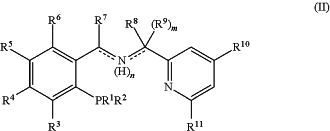| CPC C07C 41/26 (2013.01) [C07C 29/149 (2013.01); C07C 29/156 (2013.01); C07C 2602/28 (2017.05)] | 10 Claims |
|
1. A method for hydrogenating an ester with molecular hydrogen to give the corresponding alcohols at a temperature of 50 to 200° C. and a pressure of 0.1 to 20 MPa abs in the presence of a five-fold or six-fold coordinated ruthenium complex (I), wherein the ruthenium complex can also be bridged to form a dimer, wherein the ruthenium complex comprises a tridentate ligand L of the general formula (II)
 where
R1, R2 are each independently an aliphatic hydrocarbon radical having 1 to 8 carbon atoms, an aromatic hydrocarbon radical having 6 or 10 carbon atoms or an araliphatic hydrocarbon radical having 7 to 12 carbon atoms, where the hydrocarbon radicals specified are unsubstituted or substituted by 1 to 3 methoxy, thiomethoxy or dimethylamino groups, and the two radicals R1 and R2 may be bonded to each other to form a 5- to 10-membered ring including the phosphorus atom,
R3, R4, R5, R6, R10, R11 are each independently hydrogen, linear C1 to C4-alkyl, branched C3 to C4-alkyl, methoxy, hydroxyl, trifluoromethyl, nitrile or dialkylamino each independently having 1 to 4 carbon atoms per alkyl group,
R7, R8, R9 are each independently hydrogen, linear C1 to C4-alkyl or branched C3 to C4-alkyl,
n, m are each independently 0 or 1, and
the solid-dashed double lines are a single or double bond, with the proviso that
in the case of n=1, both solid-dashed double lines represent a single bond and m is 1, and
in the case of n=0, one solid-dashed double line represents a single bond and the other solid-dashed double line represents a double bond, wherein in the case of a double bond on the side facing the phenyl ring, m=1, in the case of a double bond on the side facing the pyridyl ring m=0, or both solid-dashed double lines represent a single bond and m is 1.
|